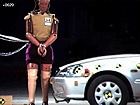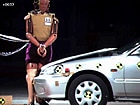Honda Develops Pop-up Hood for Pedestrian Safety; Reduces Impact to Pedestrians in the Event of a Collision
August 24, 2004, Japan
August 24, 2004-Honda Motor Co., Ltd. today announced development of a pop-up hood system for pedestrian safety, which raises the engine hood in the event of a collision with a pedestrian to reduce the possibility of a serious impact to the pedestrian's head region by providing added engine compartment clearance.
The pop-up hood for pedestrian safety employs three sensors located inside the front bumper and a vehicle speed sensor to determine if an impact with a pedestrian has occurred, then signals an actuator to raise the rear portion of the engine hood approximately 10cm. This provides a space between the hood, the engine and other hard components to reduce pedestrian head injuries.
Use of the pop-up hood for pedestrian safety can cause an approximately 40% reduction* in HIC (Head Injury Criteria) values according to Honda's internal research. This achieves a higher level of pedestrian safety performance even in models where design considerations make it difficult to provide ample clearance between the hood, the engine and other hard components.
*Based on Honda in-house measurements using a head impactor device
Honda first introduced its Pedestrian Injury Reduction Body technologies with the HR-V in 1998, employing a body structure designed to reduce impact to the head, the area of many life-threatening injuries. With the release of the Civic in 2000, further measures were added to reduce harm to the legs-a common injury location. Impact-absorbing structures are employed in the engine hood, hood hinges, wiper pivots, front fenders, bumpers, and other components. Currently, most Honda automobiles feature the Pedestrian Injury Reduction Body technologies, with total sales of such models totaling more than 3 million vehicles in Japan.
Honda has long been involved in research into safety technologies based on real-world crash conditions. Particularly in the area of pedestrian-related accidents, Honda has taken the lead over other manufacturers, unveiling the world's first pedestrian dummy, the POLAR I, in 1998, to help clarify the kinematics of accidents involving pedestrians and to support development of pedestrian protection technologies. This was followed in 2000 by the POLAR II, which features an even more human-like structure and is equipped with sensing devices at more key points of measurement. Honda is committed to the further development of technologies designed to help prevent accidents involving pedestrians.




Crash testing of the pop-up hood system for pedestrian safety using the POLAR II